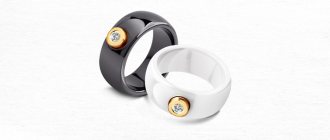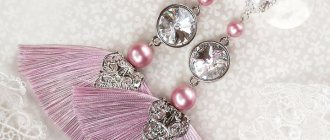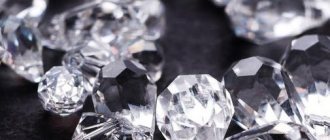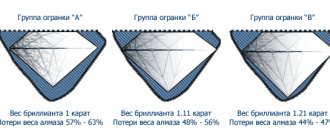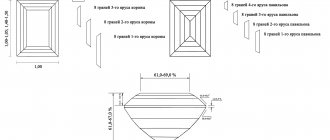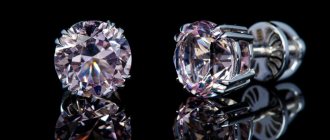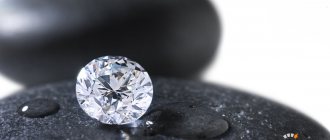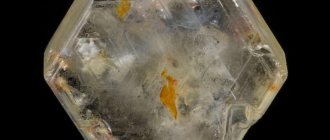October 18, 2022 The carat value of diamonds is a topic of long debate that is unlikely to subside in the coming years. The reason for this, no matter how trivial it may sound, is the high cost of the mineral. The retail price of a cut diamond is only growing, and unscrupulous sellers are constantly inventing new marking methods to hide the real mass of inlays from the buyer. That is why, when choosing a diamond ring or any other product, you need to know how much the stone weighs.
Now we will tell you how to determine how many carats are in a diamond, what calculation methods exist, and how accurate the generally accepted calculation systems are.
What is the carat value of diamonds?
History has not preserved detailed details of why the carat was recognized as the standard unit of measurement for jewelry stones, although everything happened relatively recently - in 1907. The international standard was signed by French scientists following a conference of the Paris Bureau of Weights and Measures. It is thanks to them that almost the entire world, with the exception of Anglo-Saxon countries, uses meters and kilograms instead of pounds and feet.
So, the value we are interested in is constant, but in different sources it is written in two ways - as an ordinary fraction or as a decimal fraction. One carat is equal to 1/5 or 0.2 grams, on the basis of which the net weight of the stone is calculated. It should be understood that manufacturers can and are required to indicate the total weight, and in order to measure the inlay, it will have to be pulled out of the gold cast; such an activity is problematic and requires a special jewelry tool.
Fortunately, it is quite possible to avoid radical “dissection” by going to a pawn shop or workshop - basic mathematics will come to the rescue. The two things you will need are an accurate engineering ruler with 0.1 millimeter divisions and a magnifying glass.
Star of Sierra Leone
Weight: 968.9 carats
The Star of Sierra Leone was a large emerald-shaped stone discovered in mines near the city of Koidu in Sierra Leone (West Africa). A few months after its discovery, the diamond was purchased by a New York jeweler for $2.5 million.
The initial weight of the diamond was 143.2 carats. Later reprocessing of the stone produced 17 smaller diamonds, thirteen of which were virtually flawless.
Sierra Leone Star is also known for its chemical purity.
How to determine the carat of a diamond without a scale?
Precise microscales are a useful thing, but not cheap, and branded models approved by jewelry manufacturers are profitable to buy exclusively for stores. Therefore, it is much easier to calculate the declared mass using the formula named after the legendary French merchant Jean-Baptiste Tavernier. Back in the 17th century, he managed to calculate the direct mathematical relationship between the size of a cut diamond and its specific gravity.
The formula looks like this:
M = (d*d) * h * 0.0061
The letter d denotes the diameter, h the height, and the last factor is the proportion coefficient of the stone; it remains conditionally constant. The only practical difficulty is to measure the dimensions with an accuracy of at least one tenth of a millimeter, otherwise the calculation makes no sense.
Important: The error of the Tavernier formula is 10-15%, depending on the deviations of the measuring instruments. That is why future owners of jewelry are advised to buy an engineering ruler in advance with the lowest possible division price.
However, the difficulties do not end here. The fact is that during the life of the eminent jeweler who supplied gems to the court of Louis XIV, they knew how to give diamonds an exclusively round shape; accordingly, for others a modified calculation will be required.
Millennium Star
Millennium Star Diamond
Weight: 777 carats Cut weight: 203.04 carats
The Millennium Star is the largest known colorless diamond in the world. It was discovered on the alluvial plains in the Mbuji-Mayi district of Zaire (present-day Democratic Republic of the Congo). It was acquired by De Beers, one of the largest diamond exploration and trading companies, during the civil war in the mid-90s.
The Millennium Diamond was first displayed publicly in 1999, as part of the De Beers Millennium Diamond Collection. In his book Diamond Geezers, journalist Chris Hollington detailed the diamond's history, including the attempted theft in 2000.
Table of carat values of diamonds of different shapes
Suppose a stone of a popular cut is inserted into a gold jewelry. Each of them will have its own proportions, which means a different closing factor. There is no need to “draw” multi-story equations - everything has been calculated long ago, the results are listed in a table:
| Cut style | Aspect Ratio | Coefficient |
| Emerald or baguette | 1:1 | 0,008 |
| 2:1 | 0,01 | |
| Marquis | 1,5:1 | 0,0056 |
| 2:1 | 0,0058 | |
| Pear | 1,25:1 | 0,006 |
| 2:1 | 0,0057 |
Accordingly, in the formula, instead of the square of the diameter, the length and width along the largest sides are added. The calculation takes the form:
M = d*a*h*k
Instead of the letter k, all that remains is to substitute the value of the rightmost column. The aspect ratio is usually written on the certificate; if it is missing, do not hesitate to contact the seller.
Cullinan III
Portrait of Queen Mary wearing the four largest Cullinan diamonds.
Cullinan III on her necklace Weight: 3106.75 carats Cut weight: 94.4 carats
On January 26, 1905, a diamond measuring 10.1 cm long and 6.3 cm wide was recovered from a mine in the small town of Cullinan, South Africa. It was three times the size of the Excelsior diamond. At that time it was named after the chairman of the mine, Thomas Cullinan.
A few months after the discovery, the rough diamonds were offered for sale, but they did not sell, despite their growing popularity. In 1907, the diamond was purchased by the Transvaal Colony (formerly a British colony in modern-day South Africa) for £150,000 as a gift to King Edward VII of England.
By order of Edward VII, the Cullinan Diamond was cut into several pieces; about nine major and 96 minor. Three of the largest Cullinans, namely Cullinan I, Cullinan II and Cullinan III, are also the largest diamonds in the world.
The Cullinan III, also known as the Little Star of Africa, is a pear-shaped diamond weighing approximately 18.8 grams (94.4 carats) and is sometimes used by Elizabeth II, Queen of the United Kingdom.
How to read the tag on a diamond item?
After we have learned how to calculate the weight of a gemstone, it is time to compare the real numbers with what the jewelry store offers us. The jewelry tag, as required by Russian law, contains all the technical information about the mineral, but to save space it is printed in an encrypted abbreviated format, for example, like this:
Engagement ring, 585, art.000000000, 1Br, 3.4-4, Kr57, 2.2 g
Here you can see that the word “carat” is missing altogether, but this is not a reason to panic and declare it a fake. The fact is that instead of an exact value, domestic manufacturers often indicate diamond screening - a range value for the number of stones (pieces) that fall on 1 carat of cut diamonds after the screening procedure through special sieves.
To decipher what has been said, let us turn to the table for the last time in this article.
| Size and weight classification of diamonds | ||
| Sieving coefficient | Carat weight | Diameter in mm |
| 200-400 | 0,002-0,005 | 0,70-1,10 |
| 90-120 | 0,008-0,009 | 1,30-1,40 |
| 30-40 | 0,025-0,029 | 1,90-2,00 |
| 7-10 | 0,100-0,139 | 3,00-3,30 |
| 3.4-4 | 0,250-0,299 | 4,10-4,30 |
Knowing the common coefficients, calculating the mass is not difficult; you just need to divide the unit by the number indicated with a hyphen by the larger indicator. The resulting decimal fraction will be the desired value with a minimum error.
Now let's return to our tag, the code on which should be read as follows: engagement ring made of 585 gold with one diamond weighing up to 0.3 carats, classic round cut with 57 facets. The total weight of the product is always indicated in grams.
Diameter to weight ratio
But is it possible to determine the mass of a stone based only on its diameter? If this applies to round stones, then yes. Thanks to their shape, you can determine their weight in grams by measuring their diameter. There is a special table that shows all the data regarding the weight of the stone and the specific size. We will provide only some information on this issue. For round stones there is the following weight estimate:
- One millimeter is five thousandths of a karat.
- Two millimeters – three hundredths of a car.
- Three millimeters is one tenth of a carat.
- Four millimeters – twenty-five hundredths of a karat.
- Five millimeters is half a car.
- Six millimeters – eight tenths of a carat.
- Six and a half millimeters - one carat.
As the diameter of the girdle increases, its weight will naturally increase. Although the weight depends on the diameter, with different cuts it will be different for the same type of gemstone. Thus, with a “princess” or “oval” cut, the consumption of waste material will be less than with a round cut, so they are more profitable from a material point of view. It also requires less effort from the jeweler.
Diamonds, size and carat. Interesting Facts
While preparing this article, we collected several interesting details:
- The international cost of 1 carat of diamond in 2022 is close to 20 thousand dollars (about 1.5 million rubles). However, this amount only applies to crystals of the highest quality and purity, which is extremely rare in mass production.
- Before the standardization of values in the 20th century, each region measured the value of stones in its own way. The seeds of barley, acacia and other dense varieties were used.
- The only country that has categorically abandoned the karate system is Japan. There, the mass of inlays is measured in funami (375 mg) or momme (3.75 g).
- The Arab world calls the unit of weight for jewelry the qirat, and its value in the metric system is 0.223 grams.
- The “folk” size of a pebble is considered to be a diameter of up to 3 mm and a weight of 0.1 kr. With average clarity and cut, the cost of the mineral does not exceed $200.
- The largest diamond in history - the Star of Africa or Cullinan - weighed 621 grams before division. Now its fragment adorns the scepter of the British King Edward VII, which can be admired in the permanent exhibition of the Tower of London.
- The bean seed of the pod ceratonia, or rather its Greek name, gave birth to the word carat. At least that's what the Greeks themselves think.
The Karatov online store will help you choose and buy jewelry with natural diamonds for every taste and budget, and if you have any questions, contact us through the feedback form. We guarantee maximum quality and authenticity of each product.
Let's decipher the characteristics
The certificate for set jewelry stones is a tag. It is on it that the main characteristics of diamonds are indicated, encrypted in a special code. Each code corresponds to either one or several identical stones fixed into the product.
The first number indicates the number of diamonds with identical characteristics.
This is followed by a code for the type of stone cut, which includes the letter designation of the diamond shape and the number of facets. Then the total carat weight of the stones with these characteristics set into the product is written. The next two numbers, indicated through a fraction, indicate the class of color and purity, respectively (according to Russian technical specifications). Next, the quality of the diamond cut is noted in accordance with the standard cut.
Diamond Clarity
Diamond clarity is another important parameter that is worth paying attention to. This concept defines its transparency and the absence of external defects of the diamond. According to this criterion, diamonds are divided into 12 groups and not only the attractiveness of the diamond, but also its external qualities and durability depend on it. In this regard, cleanliness is also of particular importance and is an integral parameter that is worth paying attention to.
When choosing the purity of diamonds, you should also focus on lower values; the closer the clarity value is to one, the higher its value. However, often the most valuable stones are not affordable for everyone, so there is such a thing as the most advantageous purity group. This is group 7, in which defects are visible only at 10x magnification using a magnifying glass, and are impossible to see with the naked eye. Therefore, if you plan to wear a diamond ring or pendant as jewelry, no one will ever guess that it has any defects. And the price of a diamond in which group will be the most profitable. It is better not to buy diamonds of clarity groups 8-12, as they may have defects that are visible without a magnifying glass. Stones below group 3 are very rarely used for the production of jewelry and are extremely expensive, bought for private collections and are of particular value. On the open market you can most often find diamonds and jewelry from groups 3 to 12.
Where did the concept come from?
Initially, in different countries and even parts of the world, precious stones, like many others, were measured in proportion to the weight of cereal grains. The cereal crop was chosen as follows: it had to be common to the area, and most of the grains had to be of the same weight. In Europe, barley grain was used for such a standard, since it was the smallest in size. Precious stones most often came from the East, so the plant that was used to measure their weight is much more logical to look for there.
Correspondence between carat and diamond size
According to one theory, the word “carat” is associated with the seeds of the acacia tree, which is often found in Mediterranean countries. Such seeds have approximately the same weight and size, and the Greek name for this plant is similar to the word “karat”. There is another version of the origin of the word. It supposedly originates from the local name of the coral tree, the average weight of a seed of which is also approximately equal to one carat. This version is considered less likely.
Among the Greeks, acacia seeds served as a weight to measure the weight of gold. The solidus gold coin, which was issued during the reign of Constantine, had a weight proportional to 24 such seeds. But this story most likely relates to another consonant concept of karat, which means a measure of the purity of the metal.
Carat of gemstones
One of the most important criteria for evaluating diamonds and other precious stones is their carat value, i.e. weight. The larger the carat, the heavier the stone, which means larger and more expensive.
Of course, carat is only an approximate way to evaluate stones, since it cannot be used to identify and describe the flaws of diamonds - the presence of inclusions, cracks, transparency, etc. However, this indicator is one of the four most important, the other three being its color, clarity and cut type.
According to the generally accepted jewelry tradition, diamonds are divided by weight into:
- diamond chips – stones up to 0.01 carats;
- small stones - from 0.01 to 0.29 carats;
- medium gems - from 0.3 to 0.99 carats;
- large, or solitaires - from 1 carat and above.
Diamonds weighing over 25 carats are so rare that each of them gets its own name and has its own history, often full of bloody events and amazing adventures.
Cullinan II
Cut weight: 317.4 carats
Cullinan II, also known as the Second Star of Africa, is the second largest stone carved from the original Cullinan. The diamond is one of the central elements of the Imperial State Crown (located under the large Black Prince Ruby), which is used during the coronation ceremony of the British Monarchy. The Cullinan II is a cut diamond with 66 facets. It has a number of scratches and minor imperfections.

